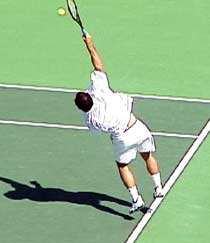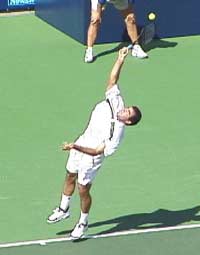<% ns_puts [mkm_getnavbar] %>

Advanced Tennis:
Sampras Second Serve
by John Yandell
|
In addition to his phenomenal first delivery, a major
component in Pete Sampras’s serving dominance has been the effectiveness
of his second serve.
At the start of this series we described the
quantitative properties of Pete’s first serve - his unique combination
of high velocity and heavy spin (part 1). The
secret to understanding his second serve is the same. Pete’s combination
of speed and spin on his second serve is as heavy or heavier than any
player in the pro game.
Using high speed digital cameras at the U.S. Open, Advanced Tennis researchers found that Pete’s second serves spin at an average rate of over 4500 rpm. In fact, the fastest spinning ball we recorded in 5 days of filming at the Open was a Sampras second serve spinning at over 5300rpm. (See www.AdvancedTennis.com)
Just go out to your car and rev your tachometer to
5000rpm or so if you want to feel the incredible level of energy this much
spin can impart to a tennis ball! And Pete combines this heavy spin with
ball speeds from 85 to 100mph or higher. The result is an incredibly heavy
second ball.
 |
 |
Note how the ball toss is further left on the second serve (right photo), moving from a position at the edge of the shoulder to virtually over the top of his head |
|
Compare this to the delivery of another top player,
such as Andre Agassi. Like Pete, Agassi’s second serve is spinning at an
average of over 4500rpm, but his average speed is less than 75mph.
So how does Pete produce this amazing second ball?
He alters the toss slightly moving the contact point further to the left.
This in turn changes the way the racquet head approaches the ball. The
result is almost twice the spin.
After spending seven articles analyzing the interplay
of technical elements in his first serve, it may seem strange to devote
only one article, the last in the Sampras serve series, to his magical
second delivery.


Like the ball toss, the contact point on
Pete’s second serve (right) also moves significantly to the left
compared to his first.
The fact is, we have already in large part analyzed Pete’s second serve technique. This is because the major components are almost identical to his first delivery: his incredible racquet drop, his perfect tossing arm motion, the “high five” motion of his hand and racquet to the ball, his full extension at contact, his relaxed, full followthrough, his advanced use of the legs and torso rotation, his “left launch” body angle, and his deceptive ability to vary his placements off a single toss placement.
Too many players believe a first serve, a second serve, or for that matter a slice serve, a kick serve, etc, are somehow all fundamentally different, as if they were distinct and unrelated motions. The elements we have examined stay consistent on all of Pete’s deliveries.
One of the secrets to the consistency of Pete's second
serve is that there is essentially only one technical change compared to
his first delivery - placement of his ball toss
further to the left, and the resulting position of the ball at the contact
point, also further to the left. From this ball
position, it also appears Pete’s racquet approaches the ball
slightly further from the left.


Compare the contact point from the sideview. The contact point on the second serve (right) is still in front of the
body, and well out over the court, only slightly less than on his first
serve (left).
As we noted, his ball placement on his first serve is
already fairly far to the left compared to other servers, a key component
in his “left launch” contact position.
If the ball is between the edge of his shoulder and his head on the first serve, it moves about a foot further to his left on the second, so that it is almost directly in line with the center of his head, when viewed from the front.
Although the toss is further left, it is important to note it still remains substantially in front of his body. Many players pull the toss back close to or even behind the plane of their bodies on the second serve, gaining spin, but losing speed.
 |
 |
On the second serve (right) the “high five” approach to the ball comes from slightly further from Pete’s left. |
|
Pete’s contact point is still in front of the plane of his body and well out into the court over the baseline. As the two photos show, he is only slightly less forward over the court than on his first serve.
The placement of the toss means that to hit with the
“high five” motion, Pete's racquet head must approach the ball more from
the left side. This shift in the angle of the diagonal on which the racquet
approaches the ball is directly responsible for the increase in spin.
Click here for Page 2
Your comments are welcome. Let us know what you think about John Yandell's article by emailing us here at TennisONE.
|
To view the complete ProStrokes Gallery of digitally mastered Pete Sampras serves, click here.
For more information on John Yandell's Advanced Tennis Research Project, click here.
Last Updated 12/15/00. To contact us, please email to: webmaster@tennisone.com
TennisONE is a registered trademark of TennisONE and SportsWeb ONE; Copyright 1995. All rights reserved.


 Visual
Tennis
Visual
Tennis